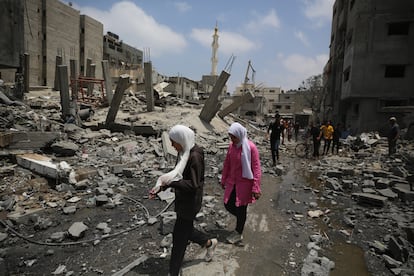The Israeli army massacre after freeing four hostages in Gaza: ‘The bombings came from all directions’
Israel admits nearly 100 people were killed in Saturday’s operation in the Nuseirat refugee camp, while the Hamas-controlled Ministry of Health puts the number at 274, including dozens of children and women

Julud Shalaq, a displaced Gazan, holds a small child with a bandaged head and wounds on his face. “He is the only one of the family that has survived,” he explains. “Him and his mother. The rest are gone [died], about 14. Even more than 14, because they are there among the rubble. The streets are full of corpses.” It is one of the stories, collected by the Al Jazeera television network, that have come to light of the massacre that occurred in the Nuseirat refugee camp on Saturday, when the Israeli army freed four hostages in a surprise operation involving hundreds of soldiers. While Israel has celebrated the success of the rescue (the largest of the war), the Gazans have been discovering the cost of it as the hours go by. Although the death toll is not clear, it is one of the largest massacres in eight months of war.
On Sunday, the Ministry of Health of the Hamas government in Gaza raised the death toll to 274 (including 64 children and 57 women) and the number of wounded to 698. Israeli military spokesman Daniel Hagari admitted he was aware of a death toll “below 100.” “I don’t know how many of them are terrorists,” he clarified. A day later, another army spokesman, Peter Lerner, refused to give figures or confirm civilians among the victims: “Hamas also doesn’t know how many civilians have been killed,” he posted on X (formerly Twitter).
The victims were transferred to two hospitals: Al-Awda, which had to extend its facilities and reported receiving 116 bodies; and Al-Aqsa Martyrs, which depends on a single electrical generator to function, has been operating above its capacities for months, and collapsed after receiving up to 94 bodies. “Total chaos,” was how Karin Huster, medical coordinator for Doctors Without Borders at Al-Aqsa Martyrs, described the situation, saying the emergency room was “completely packed with patients on the floor coming from the bombings in Nuseirat.” In a short time, up to hundreds of wounded people were in the hospital, including children and women, with “the gamut of war wounds,” she said in an audio recording released by the NGO. The Gaza Ministry of Health asked people to come and donate blood and lamented that the ambulances could not respond to all requests for help.
The images broadcast by television channels with a presence on the ground (Israel has banned the international press from entering Gaza) and by witnesses on social media show intense aerial bombardments causing columns of smoke, as well as buildings in ruins and dead and injured people on the floor. Artillery and automatic rifle fire can also be heard in the background, while dozens of civilians run for cover, scream in fear, or try to record the scene with their cell phones.
“The bombing and gunshots came from all directions. I didn’t even know where they were coming from. I am 32 years old, and I never thought I would live a moment like this,” recalled Mohamed Al Tahrani, one of the residents of the refugee camp. Three unidentified children cry uncontrollably on camera in nearby Deir al-Balah as they explain that they come from the Al-Dawa mosque area, which is in Nuseirat, an hour’s walk away. “We went to buy bread, and they did this to us,” explains one, referring to the bombings. They don’t know where their parents are.
Another resident of Nuseirat, Nidal Abdo, who was shopping at the market, estimated that around 150 rockets fell in less than 10 minutes. “While we were running away more fell on the market,” he told CNN. In a video, a boy is seen crying as he explains that he saw his friend die in front of him: “We saw him die with our own eyes. He was at the Abu Sarar roundabout [one of the bombed areas of Nuseirat], they bombed it, and he died on the bicycle.” There is an image of a dead child in the middle of the road, still on the bicycle.
The armed wing of Hamas, the Izz ad-Din al-Qassam Brigades, has claimed that the Israeli Defense Forces (IDF) killed three hostages (of the 120 remaining in Gaza) in the bombings to free the four captives, and that one also has U.S. nationality. Shortly after, it released a video of psychological warfare showing three bodies, but the footage is unclear and their identities and cause of death cannot be determined. The Israeli army has “categorically” denied this.
The IDF has admitted that they opened fire on land, sea and air, as various militiamen tried to prevent the rescue with intense fire from all directions. One border police officer was killed. The undercover Israeli troops were discovered and word spread. In the images, Palestinians are seen fleeing the bombed area while shouting to others to stay away because there are “violent explosions” and “special forces.”
These “special forces” were mista’aravim, the unit of soldiers who learn to blend in with the Arabs to infiltrate Palestinian territory, portrayed in the well-known television series Fauda. They carried mattresses in the vehicle to pose as one of the hundreds of thousands of displaced people from the Rafah area (where Israel began an offensive last month) who were looking to rent an apartment in Nuseirat. Others were disguised as Hamas militiamen.
Israeli television, witnesses and images have provided details of the rescue operation, which lasted about two hours from the first bombings. The soldiers were in two vehicles, “a small Nissan brand; and a big truck,” according to what a witness told television. Israel has denied it was a truck used to bring in humanitarian aid. In the images captured in the area, it appears to be a commercial one.
Forces from an operational unit of the intelligence services and an elite unit of the border police then got out of the vehicles and moved quickly between tents, while aircraft continued bombing the area as support. “I made sure that there would be a rain of fire at a relatively high rate to ensure that no one approached the vehicle,” the commander of the air mission, a captain identified only by the call sign Alef, told the military correspondent of Israeli television Channel 12, Nir Dvori. A drone killed a militiaman with a grenade launcher who was preparing to shoot at the truck.
The troops made a hole in a wall to access one of the two buildings. They entered the two apartments simultaneously to prevent anyone from notifying the other captors. In one building was Noa Argamani; in the other, about 200 meters away, the three men: Almog Meir Jan, Andrey Kozlov and Shlomi Ziv. The four had been taken hostage in the Hamas October 7 attacks on an open-air festival near Gaza.
The evacuation vehicle had a technical problem and could not move off the street. To prevent it from being surrounded by militiamen, the IDF mobilized several tanks that were stationed nearby for emergency situations. The air force continued to bombard the entire area extensively, according to the captain. Fifteen minutes later, they towed the vehicle to the coast, where helicopters took the hostages out of Gaza. The United States has denied that the helicopters left from the temporary pier it has installed for the entry of humanitarian aid.
Sign up for our weekly newsletter to get more English-language news coverage from EL PAÍS USA Edition
Tu suscripción se está usando en otro dispositivo
¿Quieres añadir otro usuario a tu suscripción?
Si continúas leyendo en este dispositivo, no se podrá leer en el otro.
FlechaTu suscripción se está usando en otro dispositivo y solo puedes acceder a EL PAÍS desde un dispositivo a la vez.
Si quieres compartir tu cuenta, cambia tu suscripción a la modalidad Premium, así podrás añadir otro usuario. Cada uno accederá con su propia cuenta de email, lo que os permitirá personalizar vuestra experiencia en EL PAÍS.
¿Tienes una suscripción de empresa? Accede aquí para contratar más cuentas.
En el caso de no saber quién está usando tu cuenta, te recomendamos cambiar tu contraseña aquí.
Si decides continuar compartiendo tu cuenta, este mensaje se mostrará en tu dispositivo y en el de la otra persona que está usando tu cuenta de forma indefinida, afectando a tu experiencia de lectura. Puedes consultar aquí los términos y condiciones de la suscripción digital.
More information
Archived In
Últimas noticias
Most viewed
- Sinaloa Cartel war is taking its toll on Los Chapitos
- Oona Chaplin: ‘I told James Cameron that I was living in a treehouse and starting a permaculture project with a friend’
- Reinhard Genzel, Nobel laureate in physics: ‘One-minute videos will never give you the truth’
- Why the price of coffee has skyrocketed: from Brazilian plantations to specialty coffee houses
- Silver prices are going crazy: This is what’s fueling the rally











































